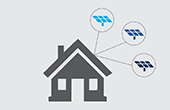History of solar policy in New Jersey
Over the past decade, the Garden State has firmly established itself as a perennial leader in solar energy. As of 2018, New Jersey has installed over 2,700 megawatts (MW) of solar electricity capacity, ranking the state 6th in SEIA’s national rankings. While high electricity prices and decreasing solar costs have definitely been helpful aspects for this success, New Jersey’s solar policies have undoubtedly been the key driver in developing the industry in the state.
In 1978, New Jersey implemented Solar Easements regulations. Although the policy didn’t focus on financial incentives, it recognized solar energy use as a property right, ensuring that proper sunlight is made available to those who install solar-energy systems. Policymakers soon after passed the state’s first financial solar incentive with the Solar Energy Sales Tax Exemption in 1980. Today, the tax break continues to help save homeowners a considerable 7 percent on any purchased solar equipment.
New Jersey would hold off on passing any further policies until 1999, when the state’s electric-utility restructuring legislation required utilities to adopt net metering, a public benefits fund, and a Renewable Portfolio Standard (RPS). All three of these programs have been crucial to solar development in the Garden State, especially as they have been amended over the years.
Looking first at net metering, the Garden State maintains one of the top programs in the nation. Net metering is an energy billing system that provides homeowners credit based on how much net surplus generation is sent back to the electric grid. Where other net metering programs provide the lower wholesale or avoided cost rate for energy sold back to the grid, New Jersey’s utilities must compensate their customers at the higher retail rate each month, helping those consumers save more money on energy bills. Additionally, the state made solar even more accessible to all consumers by lifting the original system size cap.
The next major renewable policy to come from the 1999 electricity restructuring legislation was a public benefits fund, otherwise known as the Societal Benefits Charge (SBC). Since its inception, the purpose of the fund has been to support various statewide energy initiatives. It collects revenue through a non-bypassable charge of around 3.8 percent on every resident’s energy bill. In regards to renewable energy, the SBC funds the BPU-administered New Jersey Clean Energy Program (NJCEP), which has invested over $2.635 billion since 2001 to support energy efficiency and renewable technologies or subsidy plans. Accordingly, the NJCEP has calculated that from 2001 to 2010 alone their investments have generated approximately 18.7 MWh of renewable generation and that every dollar invested in the energy efficiency program returns $4.00 in savings for the residential customer.
While the aforementioned policies have been essential to the state’s solar development, the most significant policy may be New Jersey’s RPS. Similar to net metering, state energy requirements have been imperative to the development of clean energy across the nation. In this case, New Jersey has stood out amongst other states by continuing to increase its required renewable energy levels over the years. In the beginning of the program, the state first required utilities to source 4 percent of their retail electricity sales from renewable energy sources by 2012. The policy was amended in 2004, and again in 2006, to require utilities to supply 22.5 percent of electricity with renewables by 2021, as well as to include a solar carve-out of 2.12 percent. In 2018, New Jersey again increased its RPS requirement to 35 percent by 2025 and 50 percent by 2030, along with an additional bump in the solar carve-out to 5.1 percent by 2021.
A large reason for solar growth in New Jersey stems from the state’s Solar Renewable Energy Credits (SRECs) market. Created in 2004 as part of the RPS revision that established a solar carve-out, the purpose of this system has been to help utilities meet their RPS compliance levels. For residents, these solar performance payments have been the best financial incentive to go solar. Although prices are determined by market factors, in 2019 they have hovered around $220, meaning a 5-kilowatt (kW) system that generates 5 MWh per year, could sell those credits for as much as $1,100 each year. Importantly, the recent 2018 RPS revision will retire the current SREC market when the 5.1 percent solar carve-out is reached.














